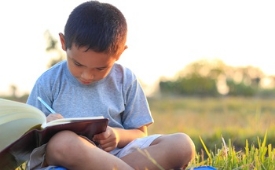Personalization & Differentiation Strategies
Contributions by Tiffiny Webster, Special Projects Coordinator and High School Education Advisor
Sage Oak Special Projects Coordinator and High School Education Advisor, Tiffany Webster, presented helpful resources to teachers and leadership in attendance at the 2021 APLUS+ conference in Anaheim, CA. Her interactive breakout session outlined the benefits of personalization and differentiation, which are aiding the evolution of education. We’re living in times fully influenced by technology, paired with a demand to cater to the needs of children individually rather than generally. As a result, Sage Oak’s personalized learning model meets that demand to serve all student learning styles and needs. Learning is not one-size-fits-all, and while education is experiencing a great shift, Sage Oak offers flexibility and adaptability through personalized learning and differentiated instruction.
What is personalization and differentiation? Personalization is mainly focused on creating a personal learning path for students depending on their interests and styles. Differentiation focuses on the teacher’s ability to transform their lessons to fit different types of learning for their various students. Both methods are beneficial to students as they provide a method of teaching fit for each student’s needs in order for them to be successful.
Tiffiny polled attendees in the audience at the APlus+ conference to ask their motivation behind personalization and differentiation. Just over 80% of the attendees responded that they are motivated to personalize and differentiate so that their students learn in a way that’s best for them.

Types of students
All roads lead to Disneyland! But, how do you get there? If you were to go to Disneyland and poll those in attendance, you’d find not everyone reaches their destination the same way. Some may have lived locally and drove in, flown in, stayed overnight in a hotel, or even walked. One thing everyone has in common is that their end goal is to get to Disneyland, and they did. So when thinking about education, there are many different types of students, and our end goal for them is to be successful and master content. Take a moment to think about what kind of learners you may have:
Carpoolers: They talk it out and learn from each other.
Scenic Drivers: Take a long way around but eventually get there.
Fast Drivers: On the fast track, they have their destination in mind and get there quickly.
Solo Drivers: By themselves and enjoy a quiet environment.
Chauffeured: Need a lot of resources and someone to be right there guiding them.
Lost Drivers: No matter which way you tell them, they always get confused so we have to help with GPS and milestone goals.
Pit Stoppers: Need a snack or brain breaks often, because they can get distracted easily.
Cautious Drivers: Map everything out, two phones with directions, an abundance of resources and assurance.
Singing Drivers: Having a good ol’ time with the roof off and they’re cruising along.

Why do we personalize and differentiate? You may be asking, is it worth the extra hours and work to teach this way? Absolutely! This is what makes it meaningful because teaching is a two-way street. A teacher provides students with the tools to engage, and in return, are able to feed their souls too because they’re spreading the joy of their success to other students and colleagues.
Personalization and differentiation also give students a sense of focus and ownership of the curriculum they’re learning. Once a student feels ownership, this produces more engagement, initiated by the teacher, and develops an internal awareness. The educational environment then shifts from a teacher-centered environment (teaching curriculum, testing, overall letter grades) to a student-centered environment (engagement, independent projects, grading based on content), and this leads to student empowerment!
Vygotsky’s zone of proximal development explains the different spaces of what a learner can do based on the tools provided to them.

How do we personalize and differentiate?
Keep it simple. Don’t drain your skillset by producing new ideas for every lesson plan.
Don’t reinvent the wheel, customize it. Work smarter, not harder.
Keep it duplicatable. Grade students based on content and develop general rubrics to get a greater reach.
How to maximize and manage these skills?
Brainstorm a list of topics your student wants to know more about.
- This could be for general interests
- This could be for sub-topics
- This could be for elective courses
Form collaborative teams to explore, research, and present on the topic.
Assess student academic and interest levels, attitude, and prior knowledge using a quick 5-point scale or form. (Likert)
Model the process of reading, questioning, researching, taking notes, organizing information, and completing a project.
S-L-O-W-L-Y develop projects, menus, and rubrics that allow students more voice and choice.
Click here to view the presentation.

